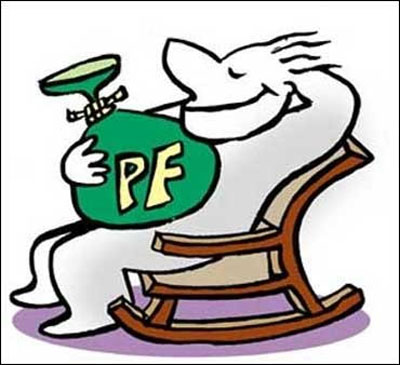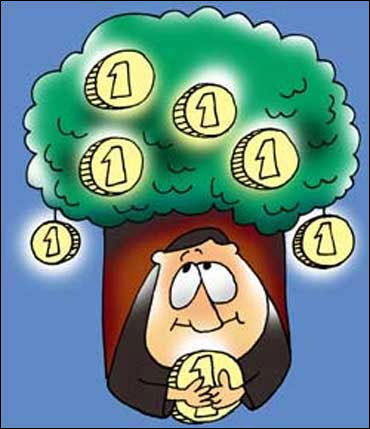 | « Back to article | Print this article |
One withdrawal from Provident Fund can cost you Rs 21 lakh
Very few are prompt enough to transfer their employee provident fund (EPF) corpus within a year of changing their job. Most leave their EPF corpus un-transferred for years.
The reasons: Some don't think that's important, as, being a percentage of basic pay, it may not be a huge corpus. Withdrawing the money takes three to six months, while transferring an account turns out to be more difficult.
Sometimes, applications get misplaced or it gets difficult to follow up with human resource executives in previous companies (being an ex-employee does not help). Some think the cumbersome process it entails may not be worth their time.
As a result, a large chunk of such individuals prefer withdrawing the corpus rather than transferring.
Click on NEXT for more...
One withdrawal from Provident Fund can cost you Rs 21 lakh
But, nowadays, not transferring is also not a great option, as the EPF Organisation does not allow paying interest on inactive accounts. That is, there is no interest paid on your account with your previous employer, where no deposit happens after you quit.
Also, withdrawing is not an option financial planners advise, as EPF forms the debt part of your portfolio and gives good tax-free returns.
"We suggest individuals changing jobs transfer their EPF corpus and do not withdraw it. EPF is currently offering an unparalleled 8.25 per cent annually, which is not taxable. Hence, it is best to stay invested in," says Suresh Sadagopan, a certified financial planner.
Withdrawing after each job can reduce the corpus significantly, while continuing with it can help earn a good amount on retirement.
Click on NEXT for more...
One withdrawal from Provident Fund can cost you Rs 21 lakh
Here's why
Assume a 30-year-old has accumulated Rs 1 lakh as EPF by contributing Rs 5,000 a month (employer+employee).
It is assumed an individual's salary increases by 10 per cent every year, and, so does the EPF contribution, till he is 60.
So, as mentioned, the deposit of Rs 5,000 a month into the individual's EPF account when he is 30 becomes Rs 5,500 the next year.
The rate of interest payable on the EPF corpus is also assumed to be constant at the present annual rate of 8.25 per cent.
Click on NEXT for more...
One withdrawal from Provident Fund can cost you Rs 21 lakh
As shown in the table, if the individual does not make any withdrawal throughout his career, he takes home a corpus of Rs 99 lakh.
Now, say the individual withdrew 50 per cent of the corpus at the end of the fourth year. In this case, at the age of 34. So, the Rs 533,000 corpus at the end of the fourth year gets reduced to Rs 266,000. However, the individual continues contributing to the account thereafter. Hence, the corpus at the end of the fifth year stands at Rs 357,000.
This would see the total EPF corpus dip to Rs 78 lakh (Rs 7.8 million) at the time of retirement. This means, the individual lost Rs 21 lakh in 30 years because of one withdrawal of 50 per cent corpus early on in this tenure.
| A pot of gold Contribution per month: Rs 5,000 | ||||
| Age (yrs) | Starting amount of accumulation in the PF account | Scenario 1 | Scenario 2 | Scenario 3 |
| 30 | 100,000 | 1,62,460 | 1,62,460 | 1,62,460 |
| 31 | | 2,44,569 | 2,44,569 | 2,44,569 |
| 32 | | 3,33,452 | 3,33,452 | 3,33,452 |
| 33 | 4,29,668 | 4,29,668 | 4,29,668 | |
| 34 | 5,33,821 | 5,33,821 | 5,33,821 | |
| 35 | 6,46,568 | 3,57,637 | 6,46,568 | |
| 36 | 6,99,909 | 3,87,142 | 6,99,909 | |
| 39 | 11,98,564 | 8,01,824 | 11,98,564 | |
| 40 | 13,66,151 | 9,36,681 | 7,17,429 | |
| 41 | 15,47,565 | 10,82,663 | 8,45,322 | |
| 45 | 24,35,750 | 17,97,379 | 14,71,480 | |
| 50 | 40,25,615 | 30,76,733 | 25,92,312 | |
| 55 | 63,88,812 | 49,78,381 | 42,58,332 | |
| 60 | 99,01,499 | 78,05,016 | 67,34,725 | |
| Note : We are starting with Rs.1 Lakh at age 30 in all scenarios; Rs.5,000/-pm is the contribution which increases every year @10% pa. Scenario 1: PF amount not withdrawn & Rs 5,000 pm contribution going on Scenario 2: 50% withdrawn at 35 & Rs 5,000 pm contribution going on since beginning Scenario 3: 50% withdrawn at 40 & Rs 5,000 pm contribution going on since beginning | ||||
Click on NEXT for more...
One withdrawal from Provident Fund can cost you Rs 21 lakh
And, there is the tax angle, too. If you withdraw the EPF amount without completing five years of service with an employer, the corpus withdrawn is taxed.
The amount is added to your salary income and taxed accordingly. On the other hand, if left untouched, it is completely tax-free.
Assuming the individual falls in the 30 per cent tax bracket, the amount he withdrew (Rs 266,000) is reduced to Rs 186,000.
If the person has to withdraw 50 per cent of the corpus at the end of the ninth year, that is, when he is 39, the EPF corpus is reduced from Rs 11.98 lakh (Rs 1.2 million) to Rs 599,000.
Given that the person continues contributing to the corpus and the contribution increases by 10 per cent every year, the total corpus in the 10th year (age 40) stands at Rs 700,000.
Click on NEXT for more...
One withdrawal from Provident Fund can cost you Rs 21 lakh
As a result, the EPF corpus on retirement further drops to Rs 67.34 lakh (Rs 6.7 million).
This means, had the individual not withdrawn from 50 per cent of the corpus, he would have had Rs 31.66 lakh (Rs 3.16 million) more for his post-retirement days.
Even if he had withdrawn in the earlier years, he would have had Rs 10 lakh more in hand.
In this case, assuming the individual continued with the same employer for nine years, his withdrawal would not be taxed.
However, if he had quit a job and taken another one in between, say at the end of the fifth year (that is, at the age of 35), he would be taxed at 30 per cent, lowering his withdrawal to Rs 419,000.
Click on NEXT for more...
One withdrawal from Provident Fund can cost you Rs 21 lakh
EPF corpus should not be dipped into, unless it's a dire need and there is no other option. Sumeet Vaid, founder, Freedom Financial Planner, had earlier suggested that, if possible, the withdrawn EPF amount should be invested, and not used to meet expenses.
If the amount is invested in a debt-equity ratio of 20:80 in mutual funds, assuming a debt return of eight per cent and equity return of 15 per cent, the corpus could be huge.
However, Sadagopan reminds that debt and equity are much riskier asset classes and could never match the uninterrupted average return of eight per cent a year.







